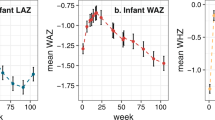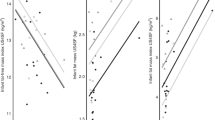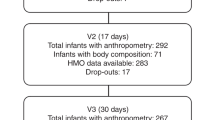Abstract
Background/Objectives:
Excessive infant weight gain in the first 6-month of life is a powerful predictor of childhood obesity and related health risks. In mice, omega-6 fatty acids (FAs) serve as potent ligands driving adipogenesis during early development. The ratio of omega-6 relative to omega-3 (n-6/n-3) FA in human milk (HM) has increased threefold over the last 30 years, but the impact of this shift on infant adipose development remains undetermined. This study investigated how maternal obesity and maternal dietary FA (as reflected in maternal red blood cells (RBCs) composition) influenced HM n-6 and n-3 FAs, and whether the HM n-6/n-3 ratio was associated with changes in infant adipose deposition between 2 weeks and 4 months postpartum.
Subjects/Methods:
Forty-eight infants from normal weight (NW), overweight (OW) and obese (OB) mothers were exclusively or predominantly breastfed over the first 4 months of lactation. Mid-feed HM and maternal RBC were collected at either transitional (2 weeks) or established (4 months) lactation, along with infant body composition assessed using air-displacement plethysmography. The FA composition of HM and maternal RBC was measured quantitatively by lipid mass spectrometry.
Results:
In transitional and established HM, docosahexaenoic acid (DHA) was lower (P=0.008; 0.005) and the arachidonic acid (AA)/DHA+eicosapentaenoic acid (EPA) ratio was higher (P=0.05; 0.02) in the OB relative to the NW group. Maternal prepregnancy body mass index (BMI) and AA/DHA+EPA ratios in transitional and established HM were moderately correlated (P=0.018; 0.001). Total infant fat mass was increased in the upper AA/DHA+EPA tertile of established HM relative to the lower tertile (P=0.019). The amount of changes in infant fat mass and percentage of body fat were predicted by AA/EPA+DHA ratios in established HM (P=0.038; 0.010).
Conclusions:
Perinatal infant exposures to a high AA/EPA+DHA ratio during the first 4 months of life, which is primarily reflective of maternal dietary FA, may significantly contribute to the way infants accumulate adipose.
This is a preview of subscription content, access via your institution
Access options
Subscribe to this journal
Receive 12 print issues and online access
$259.00 per year
only $21.58 per issue
Buy this article
- Purchase on Springer Link
- Instant access to full article PDF
Prices may be subject to local taxes which are calculated during checkout




Similar content being viewed by others
References
Ogden CL, Carroll MD, Kit BK, Flegal KM . Prevalence of childhood and adult obesity in the United States, 2011-2012. JAMA 2014; 311: 806–814.
Young B, Johnson SL, Krebs NF . Biological determinants linking infant weight gain and child obesity: current knowledge and future directions. Adv Nutr 2012; 3: 675–686.
Catalano PM . Obesity and pregnancy–the propagation of a viscous cycle? J Clin Endocrinol Metab 2003; 88: 3505–3506.
Flegal KM, Carroll MD, Kit BK, Ogden CL . Prevalence of obesity and trends in the distribution of body mass index among US adults, 1999-2010. JAMA 2012; 307: 491–497.
Fields DA, Gilchrist JM, Catalano PM, Gianni ML, Roggero PM, Mosca F . Longitudinal body composition data in exclusively breast-fed infants: a multicenter study. Obesity (Silver Spring) 2011; 19: 1887–1891.
Taveras EM, Rifas-Shiman SL, Belfort MB, Kleinman KP, Oken E, Gillman MW . Weight status in the first 6 months of life and obesity at 3 years of age. Pediatrics 2009; 123: 1177–1183.
Taveras EM, Rifas-Shiman SL, Sherry B, Oken E, Haines J, Kleinman K et al. Crossing growth percentiles in infancy and risk of obesity in childhood. Arch Pediatr Adolesc Med 2011; 165: 993–998.
Monteiro PO, Victora CG . Rapid growth in infancy and childhood and obesity in later life—a systematic review. Obes Rev 2005; 6: 143–154.
Belfort MB, Rifas-Shiman SL, Rich-Edwards J, Kleinman KP, Gillman MW . Size at birth, infant growth, and blood pressure at three years of age. J Pediatr 2007; 151: 670–674.
Kramer MS, Kakuma R . Optimal duration of exclusive breastfeeding. Cochrane Database Syst Rev 2012; 8: CD003517.
Eidelman AI, Richard JS . Section on B. Breastfeeding and the use of human milk. Pediatrics 2012; 129: e827–e841.
Horta BL, Loret de Mola C, Victora CG . Long-term consequences of breastfeeding on cholesterol, obesity, systolic blood pressure and type 2 diabetes: a systematic review and meta-analysis. Acta Paediatr 2015; 104: 30–37.
Buyken AE, Karaolis-Danckert N, Remer T, Bolzenius K, Landsberg B, Kroke A . Effects of breastfeeding on trajectories of body fat and BMI throughout childhood. Obesity (Silver Spring) 2008; 16: 389–395.
Li C, Kaur H, Choi WS, Huang TT, Lee RE, Ahluwalia JS . Additive interactions of maternal prepregnancy BMI and breast-feeding on childhood overweight. Obes Res 2005; 13: 362–371.
Woo JG, Martin LJ . Does breastfeeding protect against childhood obesity? Moving beyond observational evidence. Curr Obes Rep 2015; 4: 207–216.
Woo Baidal JA, Locks LM, Cheng ER, Blake-Lamb TL, Perkins ME, Taveras EM . Risk factors for childhood obesity in the first 1,000 days: a systematic review. Am J Prev Med 2016; 50: 761–779.
Innis SM . Metabolic programming of long-term outcomes due to fatty acid nutrition in early life. Matern Child Nutr 2011; 7 (Suppl 2): 112–123.
Storck Lindholm E, Strandvik B, Altman D, Moller A, Palme Kilander C . Different fatty acid pattern in breast milk of obese compared to normal-weight mothers. Prostaglandins Leukot Essent Fatty Acids 2013; 88: 211–217.
Berry R, Jeffery E, Rodeheffer MS . Weighing in on adipocyte precursors. Cell Metab 2014; 19: 8–20.
Muhlhausler BS, Ailhaud GP . Omega-6 polyunsaturated fatty acids and the early origins of obesity. Curr Opin Endocrinol Diabetes Obes 2013; 20: 56–61.
White PJ, Mitchell PL, Schwab M, Trottier J, Kang JX, Barbier O et al. Transgenic omega-3 PUFA enrichment alters morphology and gene expression profile in adipose tissue of obese mice: potential role for protectins. Metabolism 2015; 64: 666–676.
Massiera F, Saint-Marc P, Seydoux J, Murata T, Kobayashi T, Narumiya S et al. Arachidonic acid and prostacyclin signaling promote adipose tissue development: a human health concern? J Lipid Res 2003; 44: 271–279.
Massiera F, Barbry P, Guesnet P, Joly A, Luquet S, Moreilhon-Brest C et al. A Western-like fat diet is sufficient to induce a gradual enhancement in fat mass over generations. J Lipid Res 2010; 51: 2352–2361.
Alvheim AR, Malde MK, Osei-Hyiaman D, Lin YH, Pawlosky RJ, Madsen L et al. Dietary linoleic acid elevates endogenous 2-AG and anandamide and induces obesity. Obesity (Silver Spring) 2012; 20: 1984–1994.
Ailhaud G, Massiera F, Weill P, Legrand P, Alessandri JM, Guesnet P . Temporal changes in dietary fats: role of n-6 polyunsaturated fatty acids in excessive adipose tissue development and relationship to obesity. Prog Lipid Res 2006; 45: 203–236.
Kozak LP, Newman S, Chao PM, Mendoza T, Koza RA . The early nutritional environment of mice determines the capacity for adipose tissue expansion by modulating genes of caveolae structure. PloS One 2010; 5: e11015.
Bongiovanni KD, Depeters EJ, Van Eenennaam AL . Neonatal growth rate and development of mice raised on milk transgenically enriched with omega-3 fatty acids. Pediatr Res 2007; 62: 412–416.
Heerwagen MJ, Stewart MS, de la Houssaye BA, Janssen RC, Friedman JE . Transgenic increase in N-3/n-6 Fatty Acid ratio reduces maternal obesity-associated inflammation and limits adverse developmental programming in mice. PloS One 2013; 8: e67791.
Donahue SM, Rifas-Shiman SL, Gold DR, Jouni ZE, Gillman MW, Oken E . Prenatal fatty acid status and child adiposity at age 3 y: results from a US pregnancy cohort. Am J Clin Nutr 2011; 93: 780–788.
Rasmussen KM, Yaktine AL, Institute of Medicine (U.S.). Committee to reexamine IOM pregnancy weight guidelines Weight Gain During Pregnancy: Reexamining the Guidelines. National Academies Press: Washington, DC, USA, 2009.
Fein SB, Labiner-Wolfe J, Shealy KR, Li R, Chen J, Grummer-Strawn LM . Infant feeding practices study II: study methods. Pediatrics 2008; 122 (Suppl 2): S28–S35.
Rudolph MC, Wellberg EA, Lewis AS, Terrell KL, Merz AL, Maluf NK et al. Thyroid hormone responsive protein Spot14 enhances catalysis of fatty acid synthase in lactating mammary epithelium. J Lipid Res 2014; 55: 1052–1065.
Lawrence RA, Lawrence RM . Breastfeeding: A Guide for the Medical Profession 7th edn Mosby/Elsevier: Maryland Heights, MO, USA, 2011.
Van Veldhoven PP, Swinnen JV, Esquenet M, Verhoeven G . Lipase-based quantitation of triacylglycerols in cellular lipid extracts: requirement for presence of detergent and prior separation by thin-layer chromatography. Lipids 1997; 32: 1297–1300.
Rudolph MC, Karl Maluf N, Wellberg EA, Johnson CA, Murphy RC, Anderson SM . Mammalian fatty acid synthase activity from crude tissue lysates tracing 13C-labeled substrates using gas chromatography mass spectrometry. Anal Biochem 2012; 428: 158–166.
Jensen RG . Lipids in human milk. Lipids 1999; 34: 1243–1271.
German JB, Dillard CJ . Composition, structure and absorption of milk lipids: a source of energy, fat-soluble nutrients and bioactive molecules. Crit Rev Food Sci Nutr 2006; 46: 57–92.
Smit EN, Martini IA, Mulder H, Boersma ER, Muskiet FA . Estimated biological variation of the mature human milk fatty acid composition. Prostaglandins Leukot Essent Fatty Acids 2002; 66: 549–555.
Spevacek AR, Smilowitz JT, Chin EL, Underwood MA, German JB, Slupsky CM . Infant maturity at birth reveals minor differences in the maternal milk metabolome in the first month of lactation. J Nutr 2015; 145: 1698–1708.
Zou XQ, Guo Z, Huang JH, Jin QZ, Cheong LZ, Wang XG et al. Human milk fat globules from different stages of lactation: a lipid composition analysis and microstructure characterization. J Agric Food Chem 2012; 60: 7158–7167.
Jiang J, Wu K, Yu Z, Ren Y, Zhao Y, Jiang Y et al. Changes in fatty acid composition of human milk over lactation stages and relationship with dietary intake in Chinese women. Food Funct 2016; 7: 3154–3162.
Serra-Majem L, Nissensohn M, Overby NC, Fekete K . Dietary methods and biomarkers of omega 3 fatty acids: a systematic review. Br J Nutr 2012; 107 (Suppl 2): S64–S76.
Pedersen L, Lauritzen L, Brasholt M, Buhl T, Bisgaard H . Polyunsaturated fatty acid content of mother's milk is associated with childhood body composition. Pediatr Res 2012; 72: 631–636.
Pittaluga E, Vernal P, Llanos A, Vega S, Henrriquez MT, Morgues M et al. Benefits of supplemented preterm formulas on insulin sensitivity and body composition after discharge from the neonatal intensive care unit. J Pediatr 2011; 159: 926–32 e2.
Smith S . Mechanism of chain length determination in biosynthesis of milk fatty acids. J Dairy Sci 1980; 63: 337–352.
Wahlig JL, Bales ES, Jackman MR, Johnson GC, McManaman JL, Maclean PS . Impact of high-fat diet and obesity on energy balance and fuel utilization during the metabolic challenge of lactation. Obesity 2012; 20: 65–75.
Saben JL, Bales ES, Jackman MR, Orlicky D, MacLean PS, McManaman JL . Maternal obesity reduces milk lipid production in lactating mice by inhibiting acetyl-CoA carboxylase and impairing fatty acid synthesis. PloS One 2014; 9: e98066.
Cohen RM, Franco RS, Khera PK, Smith EP, Lindsell CJ, Ciraolo PJ et al. Red cell life span heterogeneity in hematologically normal people is sufficient to alter HbA1c. Blood 2008; 112: 4284–4291.
Nishimura RY, Barbieiri P, Castro GS, Jordao AA Jr, Perdona Gda S, Sartorelli DS . Dietary polyunsaturated fatty acid intake during late pregnancy affects fatty acid composition of mature breast milk. Nutrition 2014; 30: 685–689.
Brenna JT, Salem N Jr, Sinclair AJ, Cunnane SC . International Society for the Study of Fatty A, Lipids I. Alpha-linolenic acid supplementation and conversion to n-3 long-chain polyunsaturated fatty acids in humans. Prostaglandins Leukot Essent Fatty Acids 2009; 80: 85–91.
Brenna JT, Lapillonne A . Background paper on fat and fatty acid requirements during pregnancy and lactation. Ann Nutr Metab 2009; 55: 97–122.
Ellis KJ, Yao M, Shypailo RJ, Urlando A, Wong WW, Heird WC . Body-composition assessment in infancy: air-displacement plethysmography compared with a reference 4-compartment model. Am J Clin Nutr 2007; 85: 90–95.
Barbour LA, Hernandez TL, Reynolds RM, Reece MS, Chartier-Logan C, Anderson MK et al. Striking differences in estimates of infant adiposity by new and old DXA software, PEAPOD and skin-folds at 2 weeks and 1 year of life. Pediatr Obes 2015; 11: 264–271.
Brumbaugh DE, Tearse P, Cree-Green M, Fenton LZ, Brown M, Scherzinger A et al. Intrahepatic fat is increased in the neonatal offspring of obese women with gestational diabetes. J Pediatr 2013; 162: 930–6 e1.
Acknowledgements
The authors express our sincere appreciation to all study participants, those who provided critical reading, and Rachel C Janssen with the manuscript preparation. MCR by 5 K12 HD057022 BIRCWH, MCR and DJL by P30-DK048520 Nutrition and Obesity Research Center Pilot and NICHD T32-HD007186. BEY by NICHD F32-HD0978068, T32-DK007658-21, Thrasher Research Fund Early Career Award, and Center for Women’s Health Research. NFK by K24-DK083772. DJL by F32-DK101179. PSM by P01-HD038129 and R01-HD075285. Lipid mass spectrometry by NIH/NCATS Colorado CTSA Grant UL1 TR001082. This study was also supported by NIH National Center for Advancing Translational Sciences UL1 TR001082 and Colorado Clinical and Translational Science Institute grants UL1 RR025780.
Author information
Authors and Affiliations
Corresponding author
Ethics declarations
Competing interests
The authors declare no conflict of interest.
Additional information
Supplementary Information accompanies this paper on International Journal of Obesity website
Rights and permissions
About this article
Cite this article
Rudolph, M., Young, B., Lemas, D. et al. Early infant adipose deposition is positively associated with the n-6 to n-3 fatty acid ratio in human milk independent of maternal BMI. Int J Obes 41, 510–517 (2017). https://doi.org/10.1038/ijo.2016.211
Received:
Revised:
Accepted:
Published:
Issue Date:
DOI: https://doi.org/10.1038/ijo.2016.211
This article is cited by
-
Single Cell RNA Sequencing of Human Milk-Derived Cells Reveals Sub-Populations of Mammary Epithelial Cells with Molecular Signatures of Progenitor and Mature States: a Novel, Non-invasive Framework for Investigating Human Lactation Physiology
Journal of Mammary Gland Biology and Neoplasia (2020)
-
Maternal high-fat diet during suckling programs visceral adiposity and epigenetic regulation of adipose tissue stearoyl-CoA desaturase-1 in offspring
International Journal of Obesity (2019)
-
Maternal omega-3 fatty acids regulate offspring obesity through persistent modulation of gut microbiota
Microbiome (2018)
-
Air displacement plethysmography (pea pod) in full-term and pre-term infants: a comprehensive review of accuracy, reproducibility, and practical challenges
Maternal Health, Neonatology and Perinatology (2018)
-
Maternal obesity during lactation may protect offspring from high fat diet-induced metabolic dysfunction
Nutrition & Diabetes (2018)



